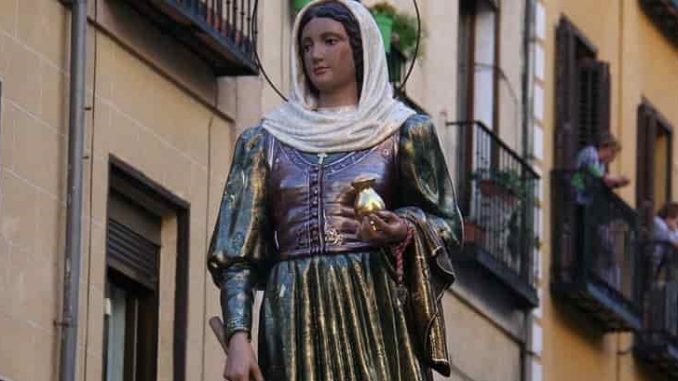Blessed Maria de la Cabeza was also known as Maria of the Head or Maria Torribia. She was a peasant woman married to Saint Isidore the Farmer.
She was born in Caraquiz, near Uceda in Guadalajara, Spain, and died in 1175 AD in Spain.
She got the title ‘of the Head’ because her head, being a relic, was venerated for centuries, and also the need to distinguish her from the many other Saints Mary’s.
| Blessed Maria de la Cabeza Biography | |
|---|---|
| Date of Birth | Around the end of the 11th century or at the beginning of the 12th century |
| Country of Birth | Spain |
| Profession | Peasant farmer |
| Place of Work | Torrelaguna, Spain |
| Date of Death | 1175 AD |
| Place of Death | Torrelaguna, Spain |
| Feast Day | September 9 |
| Beatification | August 11 1697, by Pope Innocent XII at Saint Peter’s Basilica, Papal States |
| Canonization | There is currently on process the cause for her sainthood within the Congregation for the Causes of Saints |
| Patron Saint of |
|
Blessed Maria de la Cabeza Life History
It is not yet known when Blessed Maria de la Cabeza was born, but it believed to be around the end of the 11th century or at the beginning of the 12th century. Maria Toribia was born in Caraquiz, near Uceda, in Guadalajara, Spain. Thereafter she lived in Torrelaguna, now modern-day Madrid Province.
In Torrelaguna, she met Saint Isidore the Farmer who hailed from Madrid. Sources say he may have fled Madrid due to the Almoravid invasion. They got married and begot a son called Illan.
During that time, since women were left to take care of household chores and rigorous farming activities, she relied on her husband for support and upkeep. She spent her life helping the poor, cleaning local chapels and shrines and working on the farm.
After her husband died in 1130 AD, Maria Torribia lived as a hermit. She performed miracles and it is said that she had visions like that every night she dreamed of the Blessed Virgin Mary. It is said that she would see the Blessed Virgin Mary crossing the Jarama River while extending her pure cloak over the waters.
There was a miracle associated with their son Illan whereby he fell into a deep well and after his parents prayed to God the water of the well miraculously rose to ground level and brought the child with it, and was rescued unharmed. Their son Illan would eventually die at a very young age. This made Maria Torribia and Saint Isidore the Farmer see as if God did not want them to have children. As a result, they committed themselves to a life of sexual abstinence as a form of devotion, and for the rest of their lives, they lived in different houses.
There is another miracle associated with Maria, whereby, with the knowledge that her husband, Isidore, would bring home anyone who was hungry, she would keep a pot of stew in their kitchen. One day Isidore brought a more-than-usual number of hungry people home. Maria served several of them until she saw that the stew was no more. She went and told her husband that there was no more stew for everyone. Isidore insisted that she go and check again, and miraculously the pot was full again enough for all the hungry people.
Maria Torribia Date of Birth
It is not yet known when she was born, but it believed to be around the end of the 11th century or at the beginning of the 12th century
Blessed Maria de la Cabeza Date of Death
Maria Torribia died in 1175 AD in Spain.

Nationality
Maria Torribia was born in in Spain and therefore she is a Spaniard.
Blessed Maria de la Cabeza Family, Son and Husband
Maria Torribia’s husband was St Isidore the Farmer and their son was called Illan.
Blessed Maria de la Cabeza Beatification
She was beatified in August 11 1697, by Pope Innocent XII at Saint Peter’s Basilica, Papal States
Blessed Maria de la Cabeza Canonization
There is currently on process the cause for her sainthood within the Congregation for the Causes of Saints
Blessed Maria de la Cabeza Feast Day
Her feast day is celebrated on September 9 every year and also on May 15 together with Saint Isidore the Farmer her husband
Relics
Blessed Maria de la Cabeza’s relics had been being moved several times from place to place. But in 1769 AD, the relics were eventually gathered together at the Real Colegiata de San Isidro in Madrid where they have remained there until today on display for veneration. Santa Maria de la Cabeza’s relics are interred alongside her husband Saint Isidore the Farmer’s uncorrupted body.
Veneration
When Maria Torribia became a hermit, after her husband’s death, she too performed miracles. Consequently, after her death, the people in a procession carried her head, which was conserved in a reliquary, and brought rain from heaven for the drought-stricken countryside. This merited her to get the title and the name of “Santa Maria de la Cabeza“, meaning Head.
Churches named after Blessed Maria de la Cabeza
There were three rural churches in the Diocese of Rochester, NY who in July 2011, were combined into one parish now known as Ss Isidore and Maria Torribia Parish. The new parish name was selected from among 30 names submitted by religious-education students and parishioners. The name was deemed to be very appropriate for that rural central Steuben area because Saints Isidore and Maria Torribia are the patron Saints of farmers and rural communities.
Blessed Maria de la Cabeza is the Patron Saint of
- Sabana Grande, Puerto Rico
- World Youth Day 2011
Powered By SEO Experts
Follow @ReadingCatholic
